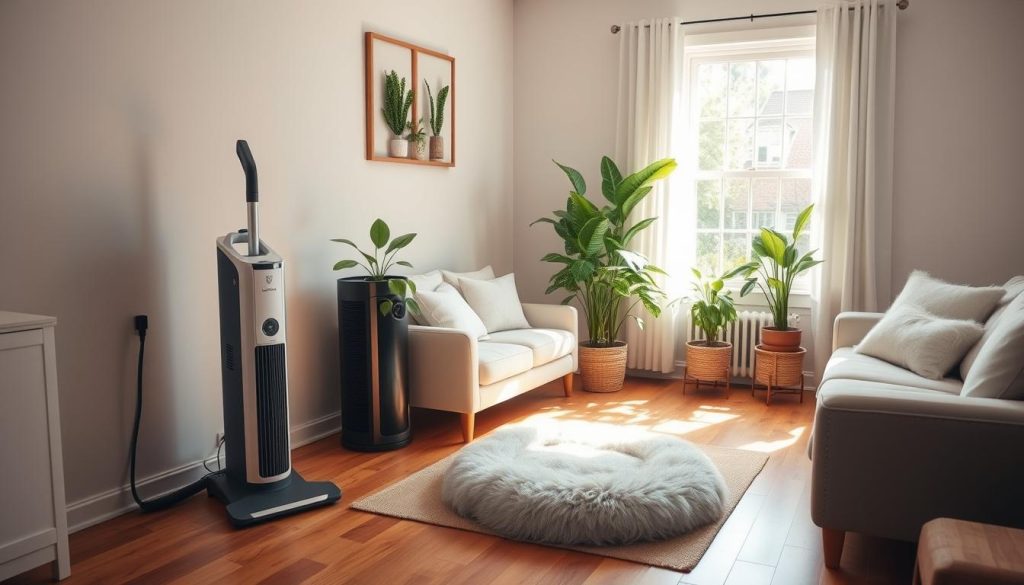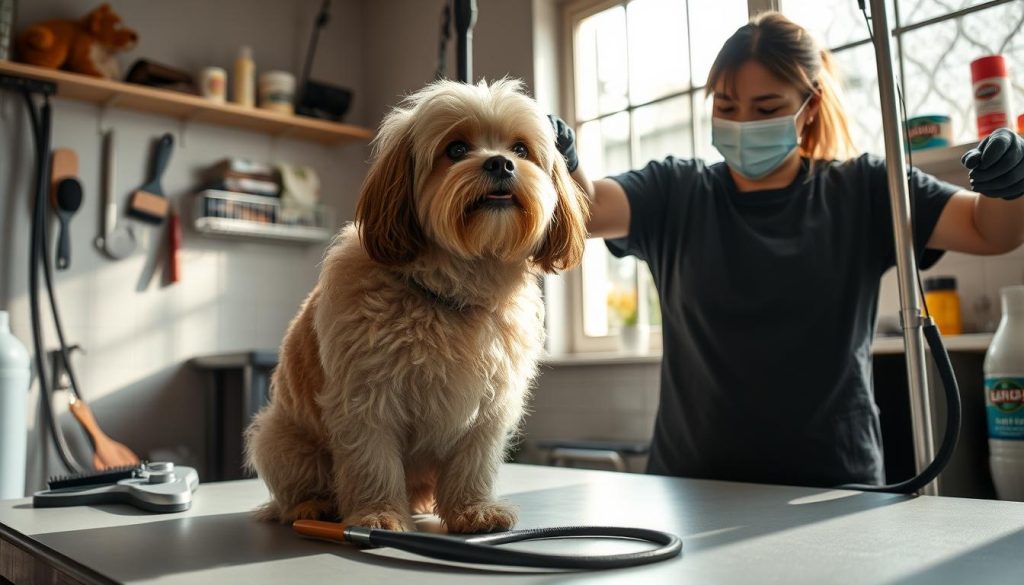As a fellow pet lover, I know how much joy pets bring to our lives. But for those with pet allergies, it can be tough. In this guide, I’ll share tips and solutions to help you manage your allergies and enjoy your pets.
If you love pets or just enjoy their company, I’ve got you covered. I’ll share ways to deal with pet allergy symptoms and live in harmony with your pets. We’ll explore common allergens and pet allergy treatment options. This guide will help you take charge of your pet allergies and live a happy life with your pets.
Understanding Pet Allergies
Dealing with pet allergies can be tough, but knowing what to do helps. You can live well with your pets by learning about common allergens and symptoms. We’ll explore how different pets can affect you.
Common Allergens and Symptoms
Most pet allergies come from proteins in dander, saliva, and urine. These proteins make your body react in bad ways. Symptoms include:
- Sneezing, coughing, and nasal congestion
- Itchy, watery eyes
- Skin rashes or hives
- Difficulty breathing or wheezing
- Headaches and fatigue
How bad these symptoms are can differ for everyone. Some people react more strongly than others.
Types of Pets and Allergy Risks
Not all pets are equal when it comes to allergies. Cats and dogs are usually the biggest problem because of their dander and saliva. But, other animals like rabbits, guinea pigs, and birds can also cause allergies. Knowing which pets are riskier helps you decide if you can have one.
| Pet Type | Allergy Risks |
|---|---|
| Cats | High levels of dander and saliva allergens |
| Dogs | Dander, saliva, and sometimes urine allergens |
| Rabbits | Fur, dander, and urine allergens |
| Guinea Pigs | Dander, saliva, and urine allergens |
| Birds | Feathers, dander, and droppings allergens |
Learning about pet allergens, symptoms, and risks helps you manage allergies. This way, you can live happily with your pets, whether they’re furry or feathered.
Minimizing Allergen Exposure

Creating an allergy-friendly home is key when dealing with pet allergies. By taking steps to reduce pet allergens, you can make your home more comfortable. This way, you can enjoy your living space without allergies getting in the way.
Crafting an Allergy-Friendly Home
Choosing the right home tips for pets with allergies is important. Start by picking furniture and surfaces that are easy to clean. This helps prevent pet dander from sticking around.
Hard floors are better than carpets, and using HEPA filters in your vacuum helps catch tiny allergens. These steps help keep your home clean and safe from pet allergens.
Regular, deep cleaning is also crucial. Clean surfaces, wash bedding in hot water, and vacuum often to get rid of pet hair and dander. Using allergy-friendly cleaning products without harsh chemicals is a good idea.
- Select low-allergen, easy-to-clean furnishings
- Utilize HEPA air filters and vacuum cleaners
- Implement a consistent, thorough cleaning routine
- Use allergy-friendly, chemical-free cleaning products
By making your home allergy-friendly, you can manage pet allergies better. This way, you can live comfortably without allergies bothering you.
Pet Allergies and Grooming Strategies

Proper pet grooming is key in managing pet allergies. As someone who lives with allergies and pets, I’ve found that regular grooming helps a lot. It makes our home more comfortable for both of us.
Managing pet allergies starts with reducing allergen sources. Pet dander, which includes dead skin cells, hair, and saliva, is a big problem. A consistent grooming routine can help control dander in your home.
- Brush your pet regularly to remove loose hair and dander. This simple step can significantly reduce the amount of allergens in the air.
- Bathe your pet frequently using a gentle, hypoallergenic shampoo. Bathing helps remove accumulated dander and allergens from your pet’s coat.
- Groom your pet outdoors whenever possible to contain the allergens and prevent them from spreading throughout your home.
- Consider professional pet grooming services if you find it challenging to manage the grooming process yourself. Professional groomers have the expertise and tools to provide a thorough and effective pet cleaning.
By adding these grooming strategies to your routine, you can cut down pet allergens in your home. This makes it more comfortable for those with allergies. Remember, regular and careful grooming is crucial for managing pet allergies and enjoying life with your pets.
Medications and Treatments for Pet Allergies

Managing pet allergies is key, and there are many ways to do it. You can change your lifestyle and environment. There are also medicines and treatments to help with symptoms. Let’s look at how you can find relief from pet allergies.
Over-the-Counter and Prescription Options
For quick relief from sneezing, itching, and watery eyes, try over-the-counter pet allergy medication. Antihistamines like cetirizine and loratadine work well. But, if your symptoms are worse, your doctor might suggest prescription pet allergy treatments. These could be nasal corticosteroids or leukotriene inhibitors.
Immunotherapy and Allergy Shots
If you want a long-term fix for your pet allergy, think about immunotherapy or allergy shots. These treatments slowly introduce you to the allergens. This helps your body get used to them and lessens your reactions over time. It might take months or years, but many people see big improvements.
| Treatment | Description | Effectiveness |
|---|---|---|
| Over-the-Counter Pet Allergy Medications | Antihistamines like cetirizine and loratadine | Provides immediate symptom relief, but may not address underlying causes |
| Prescription Pet Allergy Treatments | Nasal corticosteroids and leukotriene inhibitors | Effectively manages more severe or persistent pet allergy symptoms |
| Immunotherapy and Allergy Shots | Gradual exposure to allergens to build immune tolerance | Offers long-term relief by addressing the root cause of pet allergies |
Living in Harmony with Pet Allergies
Dealing with pet allergies can be tough, but it’s not impossible. With the right steps, you can manage your symptoms and still enjoy your pets. Learning to live with pet allergies means finding a balance that works for everyone.
To keep your home allergen-free, start with regular deep cleaning. Use HEPA air filters and make some areas pet-free. Also, keep up with your pet’s grooming to cut down on dander.
Being proactive about your allergies is key. Talk to your doctor about medications or shots. Taking control of your allergies lets you spend more time with your pets.

